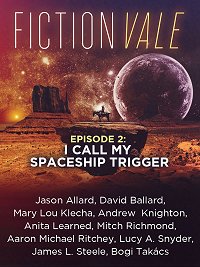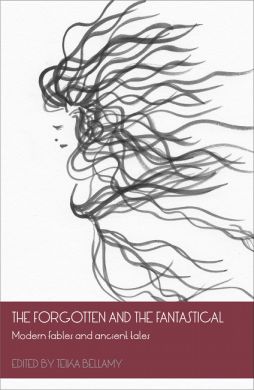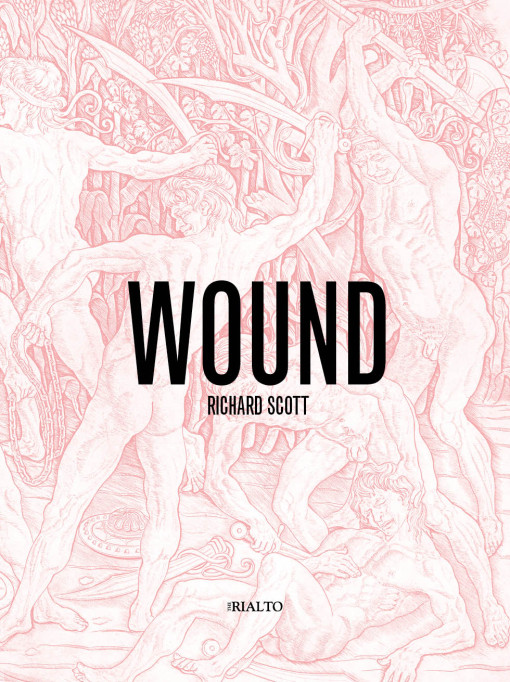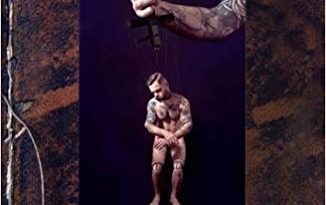Fictionvale Magazine #2: I Call My Spaceship Trigger
-Reviewed by Bethany W. Pope–
Fictionvale, edited by Venessa Giunta and Jenna Barton, is a bi-monthly short-story journal that focuses on mixed-genre stories. If you enjoyed the television show Firefly, Stephen King’s Dark Tower series, or the alternate-history of Philip K Dick’s The Man in the High Castle this magazine is right up your street. The literary quality of the stories is generally better than most in this vein, though sometimes (unfortunately) plot takes precedence over writing. I read Episode Two: I Call My Spaceship Trigger, a western/sci-fi mashup, for this review.
Episode Two opens rather weakly with ‘To Slay the Beast’. Mitch Richmond pairs a fantastic (in the old sense, ‘remote from reality’) plot involving a town being destroyed by an unnameable monster with very wooden dialogue, a trope-worthy ‘reluctant gunslinger’, and some rather clichéd writing; ‘He cringed at the cries of pain, sobs of despair, and the wailing of infants that shattered the shocked stillness.’ There is no reason to assume that genre stories cannot also be literary, but offerings like this one certainly do nothing to alter the perception that their merit is low, and that is unfortunate.
Thankfully, the quality dramatically improves with ‘Diamante & Strass’ by Lucy A. Snyder. This story features some creative, rather eerie world-building paired with characters that seem (in context) as though they could be real people. The world Snyder made is magical, post-apocalyptic, and a little tongue in cheek and it features a female coyote (people-smuggler) crossing a fantasy-American border:
“Where you gals headed?” The border agent pressed his sizzling brand into the fleshy page of the gunslinger’s passport. The booklet quivered and squeaked in his hand.
“Medicine Hat,” Diamante replied.
“Oh, be careful out there.” He gave her a smile that was two parts grandpa concern and one part raptor leer. “Take the northern route through Vauxhall; the highway through the Glassy Desert ain’t safe.”
The next two stories, ‘Four Things You’re Completely Wrong About and One You’re Not ‘, by Mary Lou Klecha and Andrew Knighton’s ‘A Sheriff in the Deep’ are readable, enjoyable, but nothing to write home about. ‘Four Things…’ resembles Michael Faber’s ‘Under The Skin’, if it were written for college students. ‘A Sheriff in the Deep’ does what it says on the tin and sets a western in a bio-dome built into the bottom of the sea.
‘Ruffians’, by Jason Allard, seems at first like a straight-forward Western; a group of bandits waits in the desert to ambush a coach. The writing is lyrical and naturalistic, embodying the ethos that the magazine is aiming for. By the time that gunshots are fired and the blood starts flowing, the story has taken an emphatic turn towards the weird;
Gillian’s marble fingers squeezed. There was a pop like a pine knot bursting in a hot fire. Harrison’s flailing legs kicked once more, then hung still. Gillian tossed him aside. Her arms retracted, slithering back to their original length. She picked up Clint’s weapon and calmly shot him in the head.
Click.
Bogi Takács ‘One of Our More Atypical Invasion Plans’ details the conquest of earth from the perspective of the aliens in thirty-one cool words.
Anita Learned’s ‘Saving Mrs Smith’ uses pithy dialogue to create a sense of naturalism and foster realistic personality, “It’s not a sack of rattlesnakes. Hold that baby up close before she slips through your fingers.”
David Ballard’s ‘A Brief History of Time Travel: Why it is a Chronic Headache and a Colossal Waste of Time’ uses the form of an academic paper to retell the story of Dr Jekyll and Mr Hyde. This story mixes humour with a sense of growing existential terror that is really quite rewarding; a morbid, enjoyable read.
James L. Steel channelled Ray Bradbury to write his contribution. ‘Beneath a Sponsored Sky’ is set in the near-future, when advertisements have taken over the world, and the heavens:
The old man sat on a rocking chair on his back porch, staring at the grass. He would have liked to look at the stars, but there were none to see. He refused to look at the animated images and logos in the sky. Decades ago, he convinced himself that turning his head to the ground was an act of rebellion, like the Mute button on the TV once was.
So the old man watched the plain, motionless grass while above him, behind the sparse clouds, animated cartoon characters danced, company logos flashed and rotated and flipped, dramatic text scrolled and zoomed in and out. Five hundred individual regions in this hemisphere, each displaying its own animation against a black background that simulated the night sky of old. Some sequences were as long as five minutes, others as short as a couple seconds, looping again and again and again from sundown to sunup.
The story is pervaded by a sense of melancholia, sweet and disheartening, fostering a sense of apprehension for a possible fate. Frankly, I thought this story was the strongest in the magazine.
The final story in the magazine is Aaron Michael Ritchey’s ‘Guns of Wounded Knee’ is well-written, but the contents are more than a little disturbing. It is slightly patronising in its revisionist portrayal of the Native Americans (providing them with alien technology to defeat the US Calvary), and the trope of the ‘Magical Native’ is in full swing here and the results are a little problematic:
Clear Eyes went on. “A messenger contacted Wovoka. A tall, thin gray man who rode down from the sky in a silver wheel. This messenger told Wovoka the history of his people. How conquerors had killed his tribe. It is an old story, is it not? Warriors with blood on their teeth and spears in their hands come to kill, to steal land, and carry off women. Not just on this world, but on others. Our gray-skinned friend said that while he could not save his people, he could save us. He gave us guns and medicine and disappeared into the stars.”
It seems that, in the mind of this author, the Native Americans require assistance from a higher power to match the strength of the whites, but they long to return to the days of ‘pure’ primitivism, ‘He closed his eyes. “In my heart is confusion. In my heart is a weary sadness. In my heart is a hope that once again, my people will hunt the buffalo with spears and arrows.” Although the author’s portrayal of Native Americans is meant to be positive, it is still presenting them as fundamentally Other.
This magazine began and ended very weakly, but there was beauty, and pleasure in the middle pages. I think that, in future, the editors should select their stories with more care, but this publication holds a great deal of promise that will (hopefully) mature in future issues.





